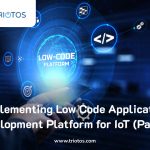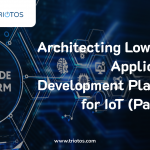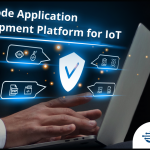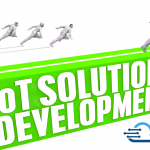
A year ago we published a blog titled Which Platform should I Choose or Use in 2023? As a year has passed it is time to revisit this subject in lieu of what has happened since then. Before we take a look at which Platform you should choose in 2024, let us take a look at some important IoT related events that appeared or continued during 2023:
- Appearance of low-cost satellite connectivity and the announcement of 5G IoT SOCs that support cellular AND satellite connectivity.
- ‘Moore’s law’ continued to offer IoT SOCs with more processing power allowing for more advanced software capabilities on IoT devices as well as longer battery lives.
- Continued consolidation of the IoT platform market. On the clod side, Google exited the market and other cloud contenders were forced to concentrate on specific segments. On the non-cloud side (although many of the smaller IoT platforms now offer cloud deployment) the number of platforms continued to decline for lack of viable business models.
- Appearance of Generative AI as an additional Analytics tool for IoT applications. Promising examples of use are many – to quote an Onica/AWS white paper on Generative AI, “by analyzing manufacturing sensor data, organizations can actively identify maintenance issues, minimize downtime and optimize maintenance schedules. By integrating your own company data, you can align operational efficiency initiatives with your specific business needs, ensuring targeted optimizations and improve overall performance.” While this is obviously general marketing hype the paper later states that “the underlying platform infrastructure must be able to support the datasets, machine learning models and data pipeline”.
2023 also saw a consolidation of the platform market. On the clod side, Google exited the market and other cloud contenders were forced to concentrate on specific segments or exit. On the non-cloud side (although many of the smaller IoT platforms now offer cloud deployment) the number of platforms continued to decline for lack of viable business models. The ones remaining have perfected their business models by offering more complete solutions monetizing them using various approaches (platform fees, per device fees, bundling with hardware etc.) One size does not fit all.
What did not change much in 2023 was the functions that an IoT platform has to provide:
- Data Handling, Processing and Transformation
- Application Server for all IoT Applications (Fixed, web, mobile, APIs)
- Common Functions and Applications (data storage, IoT device handling and provisioning, connectivity management, security, user management and applications like analytics, ML, AI and company specific)
- Support of Edge and IoT Devices (agents, operating systems, stacks, connectivities, encryptions, management, updates)
New device types and connectivities just means new provisioning, management and data model integrations. Generative AI requires increased focus on how data is stored and a focus on date unification so that IoT data can feed the new algorithms and act as one of many sources of data. The need for the IoT platform to integrate with other business systems and functions also grew stronger, meaning that integration becomes a new focus requiring additional work.
Like before, implementing IoT can still be a timely, expensive, and risky proposition – For many companies, the road towards IoT has been littered with costly failures. Choosing and Using an IoT Platform in 2024 should therefore address the following needs:
- Meet current and future business needs including new capabilities.
- Support integration with existing and new business functions
- Time of development, implementation, and introduction
- Overall cost of development, implementation, and operations
- Assessment of the risks involved.
Given this, the Do it Yourself from Scratch becomes a riskier proposition. Good for demos but not deployment and integrations. This leaves 4 of the 5 approaches describes last year.
- Do it Yourself using Existing (premise or cloud) Platform?
- Contract with IoT Platform Integrator
- Retain Systems Integrator to Develop IoT Solution
- Other Approaches
Let us discuss each of these alternatives in turn:
A – Do it Yourself using an Existing (premise or cloud) IoT Platform means that your team starts with an existing commercial platform supported by the company providing it. While this eliminates the platform development cost and time your team still must learn how to use the platform, develop all IoT applications and do all integrations. Depending on the platform chosen, there are fewer alternatives than last year, this will differ, and platform providers may be more or less open as to what the real costs are. Regardless of this, you must plan for substantial investments in engineering and integration capabilities as well as ongoing development costs. While this alternative may be appealing to many interest groups within a company it is only relevant for larger businesses that intend to create proprietary value around IoT capabilities and make this an integral part of their business. The company still has to make a substantial investment in resources for solutions that will take at least a year to develop.
B – Contract with IoT Platform Integrator is the option for companies that do not want to invest their own resources in developing and maintaining an IoT Platform and instead focus on creating value from IoT. IoT Platform Integrators come in different shapes and forms. The most common are Systems Integrator (SI) extension of IoT platform providers or stand-alone SIs specializing in one or several IoT platforms. The former will be true experts on their own platform while the latter vary in expertise ranging from ‘we will be the SI for the platform of your choice’ to ‘we specialize in providing SI services for this platform’. A third category are companies that have developed value-adding solutions on top of commercial IoT platforms like out of the box web and mobile applications or tools that make it easy to integrate these platforms within a customer environment. These companies often use the cloud IoT offerings from Microsoft, AWS and others to base their solutions on. They range from SI body shops to companies offering complete, easy to customize and integrate solutions. Cost and time to implement varies greatly among these alternatives but internal costs are reduced to critical areas like IoT devices, specialized applications, or integrations.
C – Retaining a Systems Integrator to Develop IoT Solution is an option for large and medium size companies that embark on full digitization of their business. Leading SIs like IBM, Wipro, SAP, Capgemini all have IoT practices and are ready to work with their clients to develop, source, customize and integrate IoT solutions to meet the client needs. Depending on these, solutions can be designed to meet any need and are often part of bigger projects to digitize a complete business and upgrade existing IT infrastructure. While SIs come in different sizes costs are typically in the $ millions with implementation times a year or more.
D – Other Approaches range from incorporating complete existing solutions from vendors complete with IoT devices, sensors and applications to customizing existing platforms from smaller providers. Examples of the former are tracking solutions complete with trackers and a couple of configurable applications. Examples of the latter are IoT device and sensor manufacturers that offer complete solutions targeting specific verticals. Just like with anything based on computing and communications there is no shortage of innovative solutions and new ones are introduced at a constant rate as any web search will show. Pricing models and price ranges are all over the map depending on business requirements.
So, Which Platform should I Choose or Use in 2024? As developing a solution from scratch is no longer an option, what is even more clear is that business considerations, not technical ones, should drive the decision. Let us look at key ones:
- Company Size
- Role of IoT in Business
- Budget
- Business Requirements that IoT Should Support
- Technical and Implementation Needs
- Other
I – Company Size: What is the size of your company and derived from that, how much money can you set aside for IoT initially, and on a recurring yearly level.
II – Role of IoT in Business: Strategic Program or New Product/Services/Augmentations – this will decide the centrality of IoT in the business and therefore what the IoT Platform needs to do. A New Product/Services/Augmentations focus only requires an IoT Platform supporting these specific needs and can in many cases use an existing IoT service offering from an IoT supplier supported by feature requests. A Strategic Program means that IoT will be integrated with the business requiring a more flexible IoT platform that supports ongoing integration activities. The former will be part of normal product/service development function while the latter will be funded as a separate IoT function with its own staff (engineering and mgmt.) supporting other business functions.
III – Budget: What is the budget for IoT as reflected in staffing, investment, and ongoing operations. Is it $100k as part of product/service development or is it a multi-million effort? supporting internal organization and SI services. Is IoT part of overhead budgets like IT or is it part of the operational budget of business units and part of P&L?
IV – Business Requirements that IoT Platform Should Support: These will be different for each business, and it makes sense to think through what they are, discuss them within the company and list them. A requirement is to know where customer systems are deployed for billing purposes is much easier than integrating system performance with service calls. Supporting 100 systems is different than 10,000 and requires different solutions.
V – Technical and Implementation Needs: In most cases these are straightforward with the only unknown as to how these evolve over time. Most modern IoT platforms support a wide variety of these needs, and the deciding variable will be how evolving needs are supported and the cost of these.
VI – Time to Market: While in the past the normal time to market for new IoT Solutions was counted in years this is now changing to months. There is substantial value in being able to quickly test IoT solutions from both a technical and usability perspective. The old adage Time is Money is true even in IoT.
The biggest change in Choosing and Using IoT Platforms in 2024 versus previous years is that platform technical capabilities take even more of a back seat and are overshadowed by business needs. Most providers in the current platform market offer the capabilities for developing an IoT solution and the decision comes down to time-to-market, budget and the amount of company resources you want to invest.
My company, Triotos, provides a rapid IoT onboarding platform built on top of the AWS IoT Core platform and other AWS services. It comes with a complete set of customizable applications for data/vent monitoring and processing, analytics, administration and monitoring of the IoT solution and provisioning of IoT devices and is integrated with mobile networks and applications. With this platform it is possible to develop solutions in months instead of years at a fraction of the cost.







